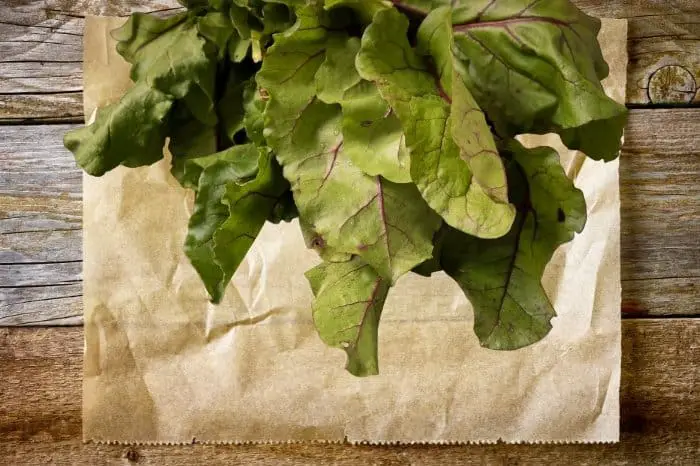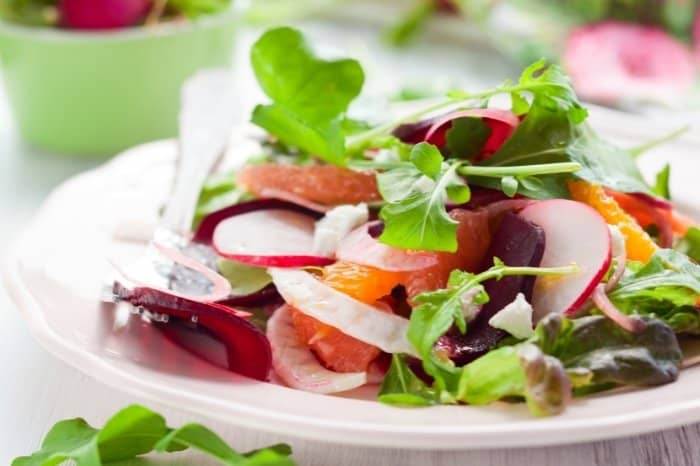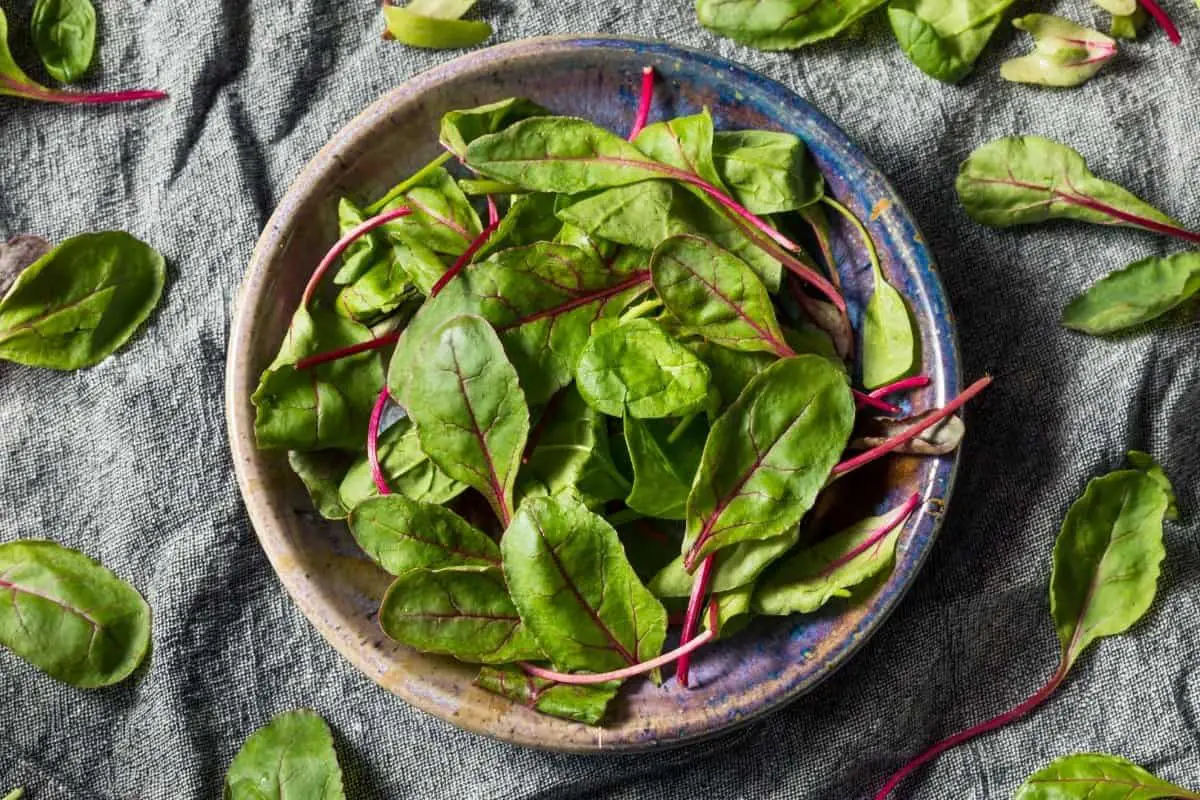Last Updated on December 17, 2022 by Griselda M.
Learning how to freeze beet greens the perfect way is the first step to ensuring you have plenty of greens during the winter season.
Beets belong to the goosefoot family and are a part of the Chenopodiaceae family. This family also includes swiss chard spinach quinoa, among other 1,500 species.
Plants in this family are rich in calcium and loved by people worldwide. Many of these plants tolerate alkaline and salty soils thriving in locations that have such kinds of soil.
Beet greens are part of the green leafy types and are a great source of dietary fiber with high vitamin A, E, and C levels. The greens are commonly substituted in recipes where swiss chard or spinach are used.
How To Freeze Beet Greens For Long-Term Use
Freezing beet greens shows that you have greens in the winter season when you have nothing growing in your garden.
Here are the steps to follow in preserving your beet greens:
Step 1 – Separate the greens from the beets. Cut them about an inch above the beetroot.
Step 2 – Sort out the greens into piles, choosing the best that you will get to preserve. For the substandard greens, sautee them for dinner or share them with your chicken or cows.
Step 3 – Wash your beet greens until they are free from the garden soil and any dirt.
Step 4 – Set a pot of water on the stove and bring it to a boil. In a separate large bowl, fill it with icy water.
Step 5 – Cut your beet greens into smaller pieces laying the leaves on top of the other and cutting them into 1-inch strips.
Step 6 – When the water begins to boil, do your beet greens into the water for 2 minutes. Remove the beet greens from the boiling water using a strainer or slotted spoon and immediately plunge them into the icy water to cool. Allow them to sit in the icy water for about a minute before squeezing out the excess water and putting them on a towel to continue cooling and drying.
Step 7 – To help your beet greens dry quickly roll them up in your towel and ensure they drip all the water out. If they have remaining water, they will get freezer burn.
Step 8 – Pack your blanched beet greens into a freezer-safe container measuring out the servings.
You will have enough beet greens for your winter use that you can add to stews, soups, frittatas, lasagna, or enchiladas. You might also enjoy putting your beet greens in smoothies, breathing a bit of summer into your winter dishes.
Can You Freeze Beets Greens Without First Blanching Them?
Yes, it is possible to freeze your beet greens without blanching them at first.
You need a large baking sheet with parchment paper to spread your greens on the surface. Using this method, lay every leaf on its own without piling them together.
Place these baking sheets in the freezer and leave them for two to three hours to freeze solid. Afterward, remove the baking sheet from the freezer and store your frozen bit greens in a suitable pack.

How Do You Freeze Uncooked Beet Greens?
Freezing raw beet greens is easy and fast. Having frozen them on the baking sheet for about 3 hours, it is time to freeze them in containers or Ziploc bags.
Ensure that you squeeze as much air out of the bags as you can. Label each of the bags with the date of preparation and place them in your freezer.
In the freezer, properly frozen uncooked beet greens will last for 8 to 12 months.
Read more about Skip Laurel Growth Rate – A Complete Guide
How Long Can Beet Greens Last In The Fridge?
Fresh raw beet greens can have their life extended by storing them in the refrigerator. Place them in plastic bags without washing them until you’re ready to use them. If properly stored, beet greens can last 3 to 5 days.
To prolong the shelf life longer than this, you will need to freeze them before storing them in the freezer.
NOVARTIS XXL Premium Glass Herb Keeper and Herb Storage Container
The Benefits Of Eating Beetroot Leaves
There are many health benefits related to eating beet greens. They include:
Beet Greens are High in Vitamin C – They play a significant role in improving your immune system in fighting colds and flu viruses.
Beet Greens Lower Blood Pressure Boosting Cardiovascular Function – These greens are high in nitrates which the body converts to nitric oxide. This helps improve blood help lower blood pressure and increase oxygen levels.
Beet Greens Improve Eye Health – Beets contain vitamin A, better known as beta-carotene and leptin. These two properties improve your health and increase your energy.
These Leaves Strengthen your Bones – They have high calcium levels that keep your bones strong, warding off osteoporosis. For vegetarians who prefer non-dairy foods, using beet greens and vegetables is a great way to add more calcium to their bodies. They also contain vitamin K, which also builds strong bones. Vitamin K and D work together with calcium to ensure bones develop properly.
Beet Greens Improve Mental Health – These greens will boost your mood and improve your mental health because they contain vitamin B6.
These Greens Boost Blood Health – Because they contain iron, they can improve overall blood health by preventing and treating anemia. Iron is a vital part of hemoglobin found in red blood cells and transports oxygen from your lungs throughout your body.

Beet Greens Create Healthy Skin – Adding beet greens to your diet ensures that you maintain healthy skin because they are high in vitamin C detoxifying the liver and promoting clear, glowing skin. The antioxidant properties of vitamin C encourage collagen production vital for skin health. Beet greens also have lots of fiber that keeps you regular and flushes out the body’s toxins to help keep your skin clear and healthy.
These Greens Improve Your Digestive System – These leaves are high in fiber that improves digestion eliminating chronic constipation. You can boost your fiber intake with these leafy greens, fruits, and vegetables to help you stay regular. Beet greens encourage healthy bacteria growth throughout your digestive tract, therefore, helping your gut.
How Do You Freeze Beet Stems?
Have you ever wondered how you freeze beet stems so that you can preserve them? Well, there are a few ways to freeze them but I found the following to be the easiest. You may find them quite useful especially if you are fond of using the stems in your meals. Beet greens can be successfully preserved by using a few important steps to prepare them before freezing. To begin with, the stems should be blanched which would require about 20-30 minutes depending on the quantity.
Thereafter, these greens should be spread out on a tray to dry which takes about an hour or two. Keep in mind that you should ensure that the stems are properly strained of excess liquid and spaced out individually to speed up the drying process. After they have completely dried, cut them into short strips and pack them in freezer bags for storage. One of the main reasons to dry them completely before storing them in the freezer is so they don’t clump together. Also, remember to discard any yellowing leaves before you start preparing the stems.
Where Can I Buy Beetroot Leaves?
Many people who love to add greens to their daily diet often ask, where can I buy beetroot leaves? This is because these leaves are not only delicious but they can be eaten raw or blanched and still taste good. They also have several health benefits if effectively incorporated into your meals. Depending on where you live and the stores that you have access to, beet greens are usually quite easy to find. Your local farmers market or supermarket should stock them as they are quite sought after.
However, if you are looking for pesticide-free beet greens or organically grown ones, then these are also widely available direct from organic farms and certain daily produce stores. You can also order them online and they will be delivered to your door. Again, this would depend on what’s available in your area. If you’re fortunate enough to be surrounded by farmers who harvest beets, then you can enjoy platefuls of beet leaves all year through.
How To Eat Beet Leaves?
Would you like to add beets to your daily diet and want to know how to eat beet leaves? If so, then I have a few great ideas for you. These scrumptious greens can be eaten raw or cooked, depending on your preference. If you prefer cooked beet leaves, then adding them to your soups or stews would definitely enhance the flavor. You can add them in cut-up or pureed which are both great ways to prepare them.
The leaves of beetroot plants are also great in pasta and as a part of pizza toppings amongst others. Additionally, these leaves can be braised as they release their flavor when cooked on their own or added to meat dishes. If you prefer eating the beet leaves raw, then you also have various options.
You can add them to your smoothies and salads, use the leaves as wraps, and make scrambled egg rolls and other dishes. Beetroot leaves are versatile and delicious and would be a great partner with any meal you decide to add them to, so your options are not limited at all.
Conclusion
There is nothing better than preparing yourself for winter by keeping the right food with the proper nutrients that your body needs.
Learning how to freeze beets will ensure you have a surplus of healthy greens to feed your loved ones throughout winter.
There’s nothing as happy and wholesome about beet greens in a smoothie that you can’t afford to miss.
Caroline is a gardener who loves to get down to the nitty–gritty of gardening. She proudly proclaims herself as a ‘dirt worshipper‘ and can often be found deep in the garden, covered in soil and singing to her plants. As a self–proclaimed ‘plant whisperer‘, Caroline believes that plants need love and attention just like any other living thing, and she loves to give them both. When she‘s not tending to her garden, you can often find her researching the latest gardening trends, or teaching others how to make their gardens thrive



